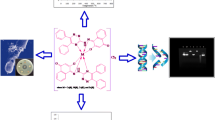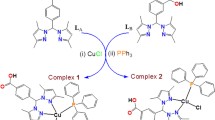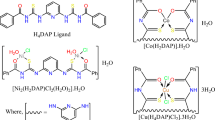Abstract
The N,O-donor bidentate ligands (L 1–L 7) derived from the reaction between chalcones and pyridinium salt of 2-acetyl furan were synthesized and characterized by IR and NMR spectroscopic techniques. Their complexes [1–7] of Cu(II) were synthesized and characterized by elemental analysis, magnetic measurements, TG analyses, IR and mass spectroscopy. Synthesized complexes were carried out for their biological elucidation using different biological experiments like minimum inhibitory concentration, DNA binding and cleavage study, cytotoxicity, and antiradical activity. Efficient cleavage of pUC19 DNA was observed for all the test complexes than the reference drug.
Graphical Abstract
Increase in DNA chain length and hence the relative viscosity as the complexes binds to DNA via intercalative mode and involves a strong stacking interaction between an aromatic chromophore and the DNA base pair.







Similar content being viewed by others
References
Kalia VC (2014) Microbes, antimicrobials and resistance: the battle goes on. Indian J Microbiol 54:1–2. doi:10.1007/s12088-013-0443-7
Kalia VC, Rani A, Lal S, Cheema S, Raut CP (2007) Combing databases reveals potential antibiotic producers. Expert Opin Drug Discov 2:211–224. doi:10.1517/17460441.2.2.211
Armitage B (1998) Photocleavage of nucleic acids. Chem Rev 98:1171–1200. doi:10.1021/cr960428+
National Committee for Clinical Laboratory Standards (1997) Methods for dilution antimicrobial susceptibility tests for bacteria that grow aerobically, 4th edn. Approved Standard NCCLS Document M7-A4, vol 17(2), NCCLS, Wayne, PA
National Committee for Clinical Laboratory Standards (1997) Performance standards for antimicrobial disk susceptibility tests, 6th edn. Approved Standard NCCLS Document M2-A6, vol 17(1), NCCLS, Wayne, PA
Tan J, Wang B, Zhu L (2009) DNA binding, cytotoxicity, apoptotic inducing activity, and molecular modeling study of quercetin zinc(II) complex. Bioorg Med Chem 17:614–620. doi:10.1016/j.bmc.2008.11.063
Boerner L, Zaleski J (2005) Metal complex–DNA interactions: from transcription inhibition to photoactivated cleavage. Curr Opin Chem Biol 9:135–140. doi:10.1016/j.cbpa.2005.02.010
Jia L, Jiang P, Xu J, Hao Z, Xu X, Chen L, Wu J, Tang N, Wang Q, Vittal J (2010) Synthesis, crystal structures, DNA-binding properties, cytotoxic and antioxidation activities of several new ternary copper(II) complexes of N, N′-(p-xylylene)di-alanine acid and 1,10-phenanthroline. Inorg Chim Acta 363:855–865. doi:10.1016/j.ica.2009.12.047
Marzano C, Pellei M, Tisato F, Santini C (2009) Copper complexes as anticancer agents. Anti-Cancer Agents Med Chem 9:185–211. doi:10.2174/187152009787313837
Neve F, Crispini A, Campagna S, Serroni S (1999) Synthesis, structure, photophysical properties, and redox behavior of cyclometalated complexes of iridium (III) with functionalized 2,2′-bipyridines. Inorg Chem 38:2250–2258. doi:10.1021/ic981308i
Patel M, Bhatt B, Dosi P (2012) Spectroscopic study of DNA hydrolysis, DNA intercalative, and electrostatic interaction activity exerted by drug based coordination compounds. Z Anorg Allg Chem 638:152–162. doi:10.1002/zaac.201100307
Martinez R, Garcia LC (2005) The search of DNA-intercalators as antitumoral drugs: what it worked and what did not work. Curr Med Chem 12:127–151. doi:10.2174/0929867053363414
Chen J, Wang X, Shao Y, Zhu J, Zhu Y, Li Y, Xu Q, Guo Z (2007) A trinuclear copper(II) complex of 2,4,6-tris(di-2-pyridylamine)-1,3,5-triazine shows prominent DNA cleavage activity. Inorg Chem 46:3306–3312. doi:10.1021/ic0614162
Xu ZH, Chen FJ, Xi PX, Liu XH, Zeng ZZ (2008) Synthesis, characterization, and DNA-binding properties of the cobalt(II) and nickel(II) with salicylaldehyde 2- phenylquinoline-4-carboylhydrazone. J Photochem Photobiol A 196:77–83. doi:10.1016/j.jphotochem.2007.11.017
Wu J, Yuan L, Wu J (2004) Synthesis and DNA interaction studies of a binuclear ruthenium(II) complex with 2,9-bis(2-imidazo[4,5-f][1, 10]phenanthroline)-1,10-phenanthroline as bridging and intercalating ligand. J Inorg Biochem 98:41–45. doi:10.1016/j.jinorgbio.2003.08.011
Raman N, Mahalakshmi R, Packiaraj M (2014) Synthesis and characterization of efficient chemical nucleases: a joint refinement from XRD, antimicrobial screening, DNA binding and cleavage investigations. Inorg Chem Commun 47:20–26. doi:10.1016/j.inoche.2014.07.011
Reddy P, Shilpa A (2011) Oxidative and hydrolytic DNA cleavage by Cu(II) complexes of salicylidene tyrosine schiff base and 1,10 phenanthroline/bipyridine. Polyhedron 30:565–572. doi:10.1016/j.poly.2010.11.015
Mohamed G, Omar M, Ahmed M, Hindy M (2005) Synthesis, characterization and biological activity of some transition metals with Schiff base derived from 2-thiophene carboxaldehyde and aminobenzoic acid. Spectrochem Acta 62:1140–1150. doi:10.1016/j.saa.2005.03.031
Asadi M, Safari E, Ranjbar B, Hasani L (2004) Thermodynamic and spectroscopic study on the binding of cationic Zn(II) and Co(II) tetrapyridinoporphyrazines to calf thymus DNA: the role of the central metal in binding parameters. New J Chem 28:1227–1234. doi:10.1039/b404068f
Ghosh K, Kumar P, Tyagi N, Singh U, Aggarwal V, Baratto M (2010) Synthesis and reactivity studies on new copper(II) complexes: DNA binding, generation of phenoxyl radical, SOD and nuclease activities. Eur J Med Chem 45:3770–3779. doi:10.1016/j.ejmech.2010.05.026
Suh D, Chaires J (1995) Criteria for the mode of binding of DNA binding agents. J Bioorg Med Chem 3:723–728. doi:10.1016/0968-0896(95)00053-J
Pilch D, Waring M, Sun J, Rougee M, Nguyen C, Bisagni E, Garestier T, Helene C (1993) Characterization of a triple helix-specific ligand. J Mol Biol 232:926–949. doi:10.1006/jmbi.1993.1440
Roberts N, Robinson P (1985) Copper chelates of antirheumatic and anti-inflammatory agents: their superoxide dismutase-like activity and stability. Br J Rheumatol 24:128–136. doi:10.1093/rheumatology/24.2.128
Vanco J, Svajlenova O, Racanska E, Muselík J, Valentova J (2014) Antiradical activity of different copper(II) Schiff base complexes and their effect on alloxan-induced diabetes. J Trace Elem Med Biol 18:155–161. doi:10.1016/j.jtemb.2004.07.003
Acknowledgments
We are thankful to the Head of Chemistry Department and UGC RFSMS Scheme for providing financial support.
Conflict of interest
The authors report no conflicts of interest.
Author information
Authors and Affiliations
Corresponding author
Electronic supplementary material
Below is the link to the electronic supplementary material.
Rights and permissions
About this article
Cite this article
Karia, P.S., Vekariya, P.A., Patidar, A.P. et al. Copper(II) Complexes with N,O-Donor Ligands and Ofloxacin Drug as Antibacterial, DNA Interacting, Cytotoxic and SOD Mimic Agent. Indian J Microbiol 55, 302–312 (2015). https://doi.org/10.1007/s12088-015-0525-9
Received:
Accepted:
Published:
Issue Date:
DOI: https://doi.org/10.1007/s12088-015-0525-9




